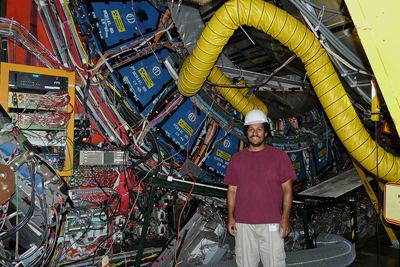New physics? Researchers see uptick in rare particle decay
By Anne Ju

An incredibly rare sub-atomic particle decay might not be quite as rare as previously predicted, say Cornell researchers. This discovery, culled from a vast data set at the Collider Detector at Fermilab (CDF), is a clue for physicists trying to catch glimpses of how the universe began.
The work, which is generating buzz because of its possible implications for the existence of new physics, has been submitted to Physical Review Letters by an international team of scientists, among them Julia Thom-Levy, Cornell assistant professor of physics, and graduate student Walter Hopkins. The paper is available on arXiv.
Thom-Levy studies the decay of particles formed in high-energy collisions, with particular focus on a class of particles called strange B-mesons that consist of a beauty quark bound to a strange quark. The Standard Model of Physics predicts the rate of strange B-mesons decaying into a pair of oppositely charged muons as exceedingly rare, with only a few decays out of 350 trillion collisions expected.
In the new data from Fermilab's Tevatron particle accelerator, the researchers found four of these decays for every one expected. While the upward fluctuation could be a statistical fluke, it is attracting widespread attention in the field because it might possibly indicate the presence of new particles and lead to an entirely new model of physics.
Over the years, as scientists were able to collide more particles at higher energies, they were able to set upper limits on the probability of such decays. The Fermilab data set has allowed scientists to further narrow the probability of the rate of decay to be between 0.46 and 3.9 x 10-9.
One possible explanation for the observed excess is the existence of supersymmetric particles, for which no evidence yet exists, but which can help explain the origin of dark matter, which makes up about one fourth of the universe.
"So this could mean an excess, and it could mean the presence of new particles, but what is needed is a lot more data to really have enough numbers to constrain this more strongly," Thom-Levy said.
Such a larger data set is being worked on now by scientists, including Thom-Levy, at the Large Hadron Collider at CERN, which runs at higher energies than the Tevatron and may eventually confirm the excess in the Fermilab data.
The work was supported by the U.S. Department of Energy, the National Science Foundation and many international institutions and organizations.
Get Cornell news delivered right to your inbox.
Subscribe